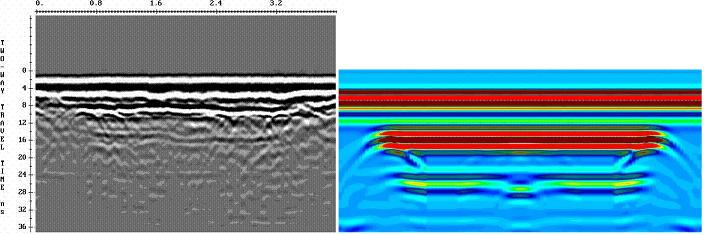







 |
Propagating electromagnetic Ground Penetrating Radar (GPR) waves are
modelled by a three-dimensional, staggered, orthogonal, fourth-order,
finite-difference time-domain (FDTD) numerical approximation to Maxwell’s
electromagnetic field equations. The scheme includes:
-
A
wide range of materials with anisotropic, frequency dependent
permittivity, conductivity and, where necessary, magnetic permeability
-
Three-dimensional target features and complex sub-surface geometries
-
Realistic antenna designs including
shields, signal damping and accurate source signal forms
-
‘Memory
variables’ to determine the time, and therefore frequency, dependant
effect of the materials on the propagating electromagnetic wave
 The software is parallelised using
message-passing (MPI) to run over a number of processors. The hardware
employed is either the
KAGe
Supercomputer or multiple Windows-based networked PCs. Each processor
(or node) must have access to the same shared disk storage. The parameters
which govern the modelling scheme are input to each sub-process from a text
file. Modelling then proceeds through a user-defined number of time-steps.
Results are written to disk at defined time-steps. Optionally checkpoints
(dump of all internal data structures) can also be specified to allow the
model to be restarted in case of hardware or power failure. The software is parallelised using
message-passing (MPI) to run over a number of processors. The hardware
employed is either the
KAGe
Supercomputer or multiple Windows-based networked PCs. Each processor
(or node) must have access to the same shared disk storage. The parameters
which govern the modelling scheme are input to each sub-process from a text
file. Modelling then proceeds through a user-defined number of time-steps.
Results are written to disk at defined time-steps. Optionally checkpoints
(dump of all internal data structures) can also be specified to allow the
model to be restarted in case of hardware or power failure. |


